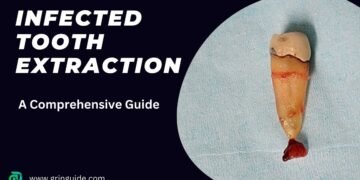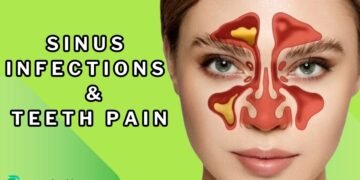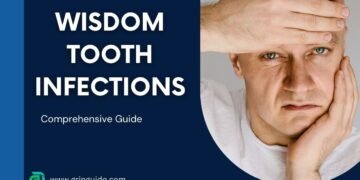Table of Contents
What is a Tooth Abscess?
A tooth abscess is a localized infection characterized by a pocket of pus that forms within the structures of a tooth or surrounding gum tissue. This condition arises due to the body’s immune response to bacterial invasion. Bacteria, often stemming from severe tooth decay, gum disease, or trauma to the tooth, penetrate the inner layers of the tooth or gum, leading to an infection. The immune system then attempts to fight off this infection, resulting in the accumulation of pus.
There are primarily two types of tooth abscesses: periapical abscess and periodontal abscess. A periapical abscess occurs at the tip of the tooth’s root. This type of abscess generally develops due to untreated dental caries that allow bacteria to infiltrate the tooth pulp – the innermost part containing nerves and blood vessels. As the infection progresses, it spreads down to the root, culminating in a periapical abscess.
On the other hand, a periodontal abscess forms in the gum tissue adjacent to a tooth. This type of abscess is often a result of advanced gum disease, also known as periodontitis. When plaque and tartar build up along the gum line, they create pockets that harbor bacteria. These bacteria can infect the gum tissue, leading to the formation of a periodontal abscess. Trauma or injury to the gums can also precipitate this condition.
Several factors can contribute to the development of a tooth abscess, including poor oral hygiene, a diet high in sugar, a weakened immune system, and previous dental procedures. Recognizing the early signs and symptoms of a tooth abscess, such as severe toothache, swelling, and sensitivity, is crucial for prompt treatment. Left untreated, a tooth abscess can lead to serious complications, making it imperative to seek dental care at the earliest indication of trouble.
Recognizing the Symptoms of a Tooth Abscess
A tooth abscess, also known as an apsis in tooth, is a severe dental condition characterized by a collection of pus caused by bacterial infection. Recognizing the symptoms early is crucial for prompt treatment and prevention of further complications.
One of the primary symptoms of a tooth abscess is a severe, persistent, and throbbing toothache that can radiate to the jawbone, neck, or ear. This toothache abscess often indicates an underlying infection that requires immediate attention.
Sensitivity to hot and cold temperatures is another common symptom. If you experience sharp pain when consuming hot beverages or cold foods, it could be a sign of an abscess at different stages of development. This sensitivity occurs because the infection can affect the nerves in the tooth, making them more reactive to temperature changes.
Swelling in the face or cheek is a visible symptom that often accompanies a swollen abscess tooth. This swelling can be localized around the infected tooth or extend to the entire side of the face, indicating the abscess’s severity. Alongside swelling, tender lymph nodes under the jaw or in the neck may become noticeable. These lymph nodes swell as part of the body’s immune response to fight the infection.
Fever is another critical symptom that suggests the presence of a periapical abscess, indicating the body’s systemic response to the infection. A persistent fever, coupled with other symptoms like toothache and swelling, necessitates urgent dental intervention to prevent further health complications. Additionally, unpleasant taste in the mouth or sudden rush of foul-smelling and foul-tasting fluid can occur if the abscess bursts, releasing the pus.
Understanding these symptoms is vital for diagnosing and assessing the severity of abscesses teeth. Early recognition and treatment can prevent the infection from spreading and causing more severe health issues. If you experience any combination of these symptoms, it is essential to seek dental care promptly to address the abscess tooth swelling and other related complications.
Stages of a Tooth Abscess
The progression of a tooth abscess can be divided into distinct stages, each characterized by specific symptoms and varying levels of severity. Understanding these stages can help in identifying the condition early and seeking appropriate treatment.
1. Initial Stage
In the initial stage of a tooth abscess, mild discomfort and sensitivity are often the first signs. This stage is characterized by a localized infection within the tooth, also known as a periapical abscess. The discomfort may be triggered by consuming hot or cold foods and beverages, or by biting down on the affected tooth. At this early stage, the infection is confined to the pulp of the tooth, and prompt dental intervention can prevent the condition from worsening.
2. Middle Stage
As the tooth abscess progresses to the middle stage, the symptoms become more pronounced. Pain and swelling are common, and the affected area may become highly sensitive to pressure. The infection begins to spread beyond the tooth pulp to the surrounding tissues, leading to noticeable swelling in the gums or face, often referred to as a swollen abscess tooth. The pain can be persistent and may interfere with daily activities, highlighting the need for immediate dental care.
3. Advanced Stage
In the advanced stage, the pain associated with the tooth abscess becomes unbearable. The infection can spread to adjacent teeth, bones, and other parts of the body, posing serious health risks. This stage is often marked by systemic symptoms such as fever, swollen lymph nodes, and general malaise. The risk of complications, including the spread of infection to the jawbone or the bloodstream, increases significantly. Emergency dental treatment is crucial at this stage to prevent irreversible damage and potential life-threatening conditions.

Recognizing the stages of a tooth abscess, from initial sensitivity to severe swelling and systemic involvement, emphasizes the importance of timely dental intervention. Early detection and treatment can prevent the progression of the infection and safeguard overall health.
Pain Management for Tooth Abscess
Managing the pain associated with a tooth abscess is crucial in ensuring patient comfort and preventing further complications. Over-the-counter pain relievers such as ibuprofen and acetaminophen can provide temporary relief from the discomfort caused by a toothache abscess. These medications help to reduce inflammation and numb the pain, making it easier to cope with the symptoms until professional treatment is obtained.
In addition to medication, applying a cold compress to the affected area can also help alleviate pain. The cold temperature constricts blood vessels, which reduces swelling and numbs the pain. To use a cold compress, wrap ice in a cloth or use a commercially available cold pack, and apply it to the cheek near the swollen abscess tooth for 15-20 minutes at a time.
Dietary modifications can also play a significant role in managing pain. Avoiding foods and drinks that are particularly hot, cold, or sugary can help prevent exacerbating the pain. Such items can irritate the abscesses teeth and lead to increased sensitivity. Sticking to soft foods and lukewarm drinks can minimize discomfort and make eating more manageable.
While these strategies can provide temporary relief, it is imperative to seek professional dental care for a proper diagnosis and treatment of a tooth abscess. A dentist can identify the specific type of abscess, such as a periapical abscess, and determine the appropriate course of action. Without professional intervention, the infection can spread, leading to more severe complications. Therefore, while pain management techniques are helpful, they should not replace the need for timely dental treatment.
Properly addressing the underlying infection is essential to resolving the issue and preventing recurrence. Only a dentist can provide the necessary treatment, whether it involves drainage, antibiotics, or other procedures. Ensuring that the abscessed tooth is professionally managed is the most effective way to achieve long-term relief and maintain oral health.
Effective Treatments for Tooth Abscess
Treating a tooth abscess effectively requires an accurate diagnosis and a tailored approach to address the infection and alleviate symptoms. The primary goal is to eliminate the infection, preserve the tooth when possible, and prevent complications. The treatment process generally begins with draining the abscess to remove the accumulated pus. This initial step is crucial as it reduces swelling and alleviates pain, providing immediate relief from a toothache abscess.
In many cases, root canal therapy is the next step to save the affected tooth. During this procedure, the dentist or endodontist removes the infected pulp from the tooth’s interior. The canals are then cleaned, disinfected, and filled with a biocompatible material to prevent further infection. A crown is typically placed on the tooth to restore its structure and function, ensuring the tooth remains intact and functional.
However, in situations where the tooth is severely damaged or the infection has spread significantly, tooth extraction might be necessary. Removing the tooth can help prevent the infection from spreading to adjacent teeth, bones, or other parts of the body. The extraction site is then carefully cleaned to ensure all infection is removed, and patients may consider options such as dental implants or bridges to replace the missing tooth.
Follow-up care is critical in the treatment of a tooth abscess. Patients are often prescribed antibiotics to combat any remaining infection and advised on proper oral hygiene practices to prevent recurrence. Regular dental check-ups are essential to monitor healing and ensure no new abscesses develop. Addressing a tooth abscess promptly and following through with appropriate aftercare can prevent severe complications and promote full recovery.
Role of Antibiotics in Treating Tooth Abscess
Antibiotics play a crucial role in managing the infection associated with a tooth abscess, particularly when the abscess is causing significant swelling or spreading to surrounding tissues. They are often prescribed when the infection is severe, there is evidence of systemic involvement, or the patient is unable to undergo immediate dental treatment. The primary function of antibiotics in treating a tooth abscess is to control the bacterial infection, thereby reducing inflammation and preventing the spread of the infection to other parts of the body.
Commonly prescribed antibiotics for tooth abscesses include penicillin, amoxicillin, clindamycin, and metronidazole. Each of these antibiotics targets different bacterial strains, and the choice of antibiotic may depend on the patient’s medical history and any potential allergies. For instance, amoxicillin is widely used for its effectiveness and broad-spectrum activity, while clindamycin is an alternative for those allergic to penicillin.
It is paramount to understand that antibiotics alone cannot cure a tooth abscess. They serve to manage the infection temporarily and alleviate symptoms such as pain and swelling. However, the root cause of the abscess, such as a periapical abscess originating from an untreated dental cavity or a cracked tooth, must be addressed through definitive dental treatment. This may involve procedures like root canals, tooth extraction, or drainage of the abscess.
The importance of completing the prescribed course of antibiotics cannot be overstated. Incomplete courses can lead to the development of antibiotic resistance, making subsequent infections more difficult to treat. Patients should follow their dentist’s instructions meticulously and report any adverse reactions to the medication promptly.
In conclusion, while antibiotics are an essential component in the management of tooth abscesses, they should be viewed as part of a broader, comprehensive treatment plan. Effective management of a tooth abscess necessitates both medical and dental interventions to fully resolve the infection and prevent recurrence.
Home Remedies for Tooth Abscess Relief
Tooth abscesses can cause significant discomfort and swelling, often necessitating immediate dental attention. However, while awaiting professional treatment, several home remedies can provide temporary relief from the symptoms of a toothache abscess. It’s crucial to emphasize that these remedies are not substitutes for professional dental care but can help alleviate discomfort.
One of the simplest and most effective home remedies is a saltwater rinse. Salt has natural antibacterial properties which can help to reduce inflammation and fight infection. To prepare, dissolve a teaspoon of salt in a cup of warm water and swish the solution around your mouth for about 30 seconds before spitting it out. Repeat this process several times a day to aid in reducing the swelling associated with a periapical abscess.
Baking soda is another household item that can offer some relief from the pain caused by a tooth abscess. Known for its antibacterial properties, baking soda can help to neutralize the acids in the mouth and prevent the spread of infection. Mix a small amount of baking soda with water to form a paste, then apply it directly to the swollen abscess tooth. Alternatively, you can add half a teaspoon of baking soda to a glass of water and use it as a mouth rinse.
Garlic, renowned for its antibacterial and anti-inflammatory properties, can also be a helpful remedy. Crushing a fresh garlic clove to release its active compound, allicin, and applying it directly to the affected area can reduce pain and bacterial activity. However, due to its strong taste, some may prefer to chew a garlic clove slightly and hold it against the apsis in the tooth for a few minutes before rinsing thoroughly.
Lastly, tea bags, particularly black tea, contain tannins which possess anti-inflammatory properties. Steeping a tea bag in hot water, letting it cool, and then placing it against the abscessed area can help reduce swelling and discomfort. The tannins in the tea can draw out some of the infection and provide a soothing effect.
While these home remedies can offer temporary relief, it is imperative to seek professional dental care to treat the underlying cause of the abscess. Ignoring a dental abscess can lead to more severe complications, and only a qualified dentist can effectively address the root of the problem.
Preventing Future Tooth Abscesses
Preventing tooth abscesses is pivotal in maintaining optimal oral health and avoiding the pain and potential complications associated with these conditions. Central to prevention is the practice of good oral hygiene. Regularly brushing teeth at least twice a day with fluoride toothpaste, flossing daily, and using antiseptic mouthwash can significantly reduce the risk of developing an abscess in tooth by removing plaque and food particles that can promote bacterial growth.
Regular dental check-ups, ideally every six months, are equally crucial. Professional cleanings help in the early identification and treatment of any dental issues, including cavities and gum disease, which can lead to abscesses teeth if left untreated. A dentist can also give personalized advice on improving oral care routines and recommend specific treatments if necessary.
Diet also plays a significant role in preventing tooth abscesses. Consuming a balanced diet rich in vitamins and minerals supports overall health, including dental health. Limiting intake of sugary and acidic foods and beverages can prevent tooth decay, a common precursor to periapikal abscess. Drinking plenty of water, particularly fluoridated water, can help rinse away food particles and bacteria.
Protecting teeth from physical damage is another essential preventive measure. Avoid using teeth as tools to open bottles or tear packages, as this can cause cracks or chips, creating an entry point for bacteria. Wearing a mouthguard during sports or other activities that pose a risk of dental injury can also prevent trauma that may lead to a swollen abscess tooth.
Finally, seeking prompt dental care at the first sign of tooth or gum problems is vital. Symptoms such as persistent toothache, gum swelling, or sensitivity should not be ignored, as early intervention can prevent the progression to advanced dental abscess stages. By adhering to these preventive measures, the risk of developing a tooth abscess can be significantly minimized, fostering long-term oral health and well-being.
FAQs
-
Can a Tooth Abscess Go Away on Its Own?
Many wonder, can a tooth abscess go away on its own? The short answer is no. A tooth abscess will not resolve without proper intervention. While the pain may temporarily subside, the infection remains and can spread to other parts of the body, leading to severe complications. Therefore, it is essential to consult a dentist at the first sign of an abscess.
-
How Serious is an Abscessed Tooth?
An abscessed tooth is a serious dental condition that requires immediate attention. If left untreated, the infection can spread to the jaw, neck, and even the brain. Symptoms such as severe toothache, fever, facial swelling, and difficulty swallowing indicate that the infection has progressed, necessitating prompt medical intervention.
-
How Do You Fix an Abscessed Tooth?
Treating an abscessed tooth typically involves draining the abscess to remove the infection. This can be achieved through various methods, including root canal therapy, which cleans out the infected pulp inside the tooth, or tooth extraction if the tooth is beyond repair. In addition to these procedures, antibiotics are often prescribed to eliminate any remaining bacteria.
-
Will a Tooth Abscess Go Away with Antibiotics?
While antibiotics can help control the infection, they alone are not sufficient to completely treat an abscessed tooth. Antibiotics can reduce the symptoms and prevent the infection from spreading, but the root cause of the abscess must be addressed through dental procedures. Therefore, antibiotics are usually part of a comprehensive treatment plan rather than a standalone solution.











